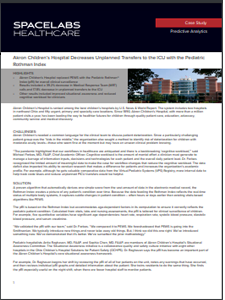Clinical deterioration of hospitalized pediatric patients could have devastating consequences. Because of this, many hospitals have turned to automated early warning score (EWS) systems to estimate patient risk early, assess changing conditions and guide critical decisions in adjusting care plans.
However, many EWS systems don’t tailor scoring parameters to address the unique needs of pediatric patients. The Rothman Index for pediatrics does.
Designed specifically for hospitalized children
The Rothman Index for pediatrics is geared towards children from the inner workings of the algorithm to the general configuration of the software.* It builds on widely validated Rothman Index technology with specific adaptations tailored for pediatrics including:
- Age-based adjustments for key input variables to accurately reflect risk:
- Heart rate
- Respiratory rate
- Blood pressure (diastolic and systolic)
- Creatinine levels
- Customized warnings designed for the pediatric population including:
- Age specific rules designed to account for differences in compensation
- Inclusion of specific clinical characteristics that serve as leading indicators of deterioration for vulnerable subpopulations (e.g., grunting, head bobbing, nasal flaring)

“A deciding factor for us was the fact that the RI captures subtle changes in patient condition since it includes nursing assessments. We expected that this would set the RI apart from the vitals-based algorithm we were using.”
—Clinical Nurse Specialist/Clinical Practice Manager

Children’s hospital decreases unplanned transfers to the ICU
Read how a children’s hospital replaced their early warning system with the Rothman Index for pediatrics and attributes it to decreases in unplanned transfers to the ICU.
HIGHLIGHTS
- Akron Children’s Hospital replaced PEWS with the Pediatric Rothman® Index (pRI) for overall clinical surveillance
- Results included a 39.2% decrease in Medical Response Team (MRT) calls and 17.8% decrease in unplanned transfers to the ICU
- Other results included improved situational awareness and reduced cognitive workload for clinicians
*The Rothman Index is not intended for use in the NICU.
REFERENCE
Rothman MJ, Tepas JJ 3rd, Nowalk AJ, Levin JE, Rimar JM, Marchetti A, Hsiao AL. Development and validation of a continuously age-adjusted measure of patient condition for hospitalized children using the electronic medical record. J Biomed Inform. 2017 Feb;66:180-193.
This product is not available for sale in all countries. Please contact your local Spacelabs Healthcare representative or regional office for more information.
